AW-CB375NF
IEEE 802.11a/b/g/n/ac Wireless LAN 2T2R and
Bluetooth 5.0 Combo Module (M.2 2230)
Datasheet
Rev. A
B2
(For STD)
1
FORM NO.: FR2-015_ A Responsible Department:WBU Expiry Date: Forever
The information contained herein is the exclusive property of AzureWave and shall not be distributed, reproduced, or disclosed
in whole or in part without prior written permission of AzureWave.
�
Features
WLAN
General
Frame aggregation
for
increased MAC
efficiency (A-MSDU, A-MPDU)
Support 802.11ac 2x2,Wave-2 compliant with
Low
latency
immediate
Block
MU-MIMO
Acknowledgement (BA)
Complete 802.11n MIMO solution for 2.4GHz
Long NAV for media reservation with CF-End
and 5Ghz band
for NAV release
Maximum PHY data rate up to 173.3 Mbps
Channel management and co-existence
using 20MHz bandwidth, 400Mbps using
40MHz bandwidth, and 866.7Mbps using
MIMO power saving mechanism
PHY-level spoofing
to enhance
legacy
80MHz bandwidth.
compatibility
Backward compatible with 802.11a/b/g devices
while operating at 802.11n data rates
Multiple BSSID feature allows the RTL8822CE-
CG to assume multiple MAC identities when
Backward compatible with 802.11a/n devices
used as a wireless bridge
while operating at 802.11ac data rates.
Host interface
Transmit Opportunity (TXOP) Short
Inter-
Frame Space (SIFS) bursting
for higher
Complies with PCI Express Base Specification
multimedia bandwidth
Revision 2.1.
Complies with USB2.0 FS-mode Specification
for Bluetooth.
PCIe LTR/L1.Off state supported.
USB Selective Suspend supported.
Standards Supported
WiFi Direct supports wireless peer to peer
applications
Other Features
Supports Wake-On-WLAN via Magic Packet
and Wake-up frame
Transmit Beamforming
IEEE 802.11a/b/g/n/ac compatible WLAN
IEEE 802.11e QoS Enhancement (WMM)
IEEE 802.11i (WPA, WPA2). Open, shared key,
and pair-wise key authentication services
Support S3/S4 AES/TKIP group key update
Support Network List Offload
CCA on
secondary
through RTS/CTS
handshake.
IEEE
802.11h DFS, TPC, Spectrum
Support TCP/UDP/IP checksum offload
Measurement
Peripheral Interfaces
IEEE 802.11k Radio Resource Measurement
Up to 15 General Purpose Input/Output pins.
WAPI
(Wireless Authentication Privacy
Two configurable LED pins.
Infrastructure) certified.
MAC Features
Generates 40MHz clock for peripheral chip.
Single external power source 3.3V only.
2
FORM NO.: FR2-015_ A Responsible Department:WBU Expiry Date: Forever
The information contained herein is the exclusive property of AzureWave and shall not be distributed, reproduced, or disclosed
in whole or in part without prior written permission of AzureWave.
�
Crystal frequency support 40MHz
Build-in both 2.4GHz and 5GHz PA.
PHY Features
IEEE 802.11ac MIMO OFDM
IEEE 802.11n MIMO OFDM
Build-in both 2.4GHz and 5GHz LNA.
Bluetooth
Bluetooth Controller
Two Transmit and Two Receive paths
Support Bluetooth 5.0 system
20MHz
/
40MHz/
80MHz
bandwidth
Compatible with Bluetooth v2.1+EDR
transmission
Integrated MCU to execute Bluetooth protocol
Support 2.4GHz and 5GHz band channels
stack
Short Guard Interval (400ns)
Sounding packet
Supports all packet types in basic rate and
enhanced data rate
DSSS with DBPSK and DQPSK, CCK
Supports Secure Simple Pairing
modulation with long and short preamble
OFDM with BPSK, QPSK, 16QAM, 64QAM
Enhanced BT/WIFI Coexistence Control to
improve
transmission quality
in different
and 256QAM modulation. Convolutional
profiles
Coding Rate: 1/2, 2/3, 3/4, and5/6.
Dual Mode support: Simultaneous LE and
Maximum data rate 54Mbps
in 802.11g,
BR/EDR
300Mbps in 11n and 866.7Mbps in 802.11ac.
Supports multiple Low Energy states
OFDM / DSSS receive diversity with MRC
Bluetooth Transceiver
using up to 2 receive paths. Switch diversity
Fast AGC control to improve receiving dynamic
used for CCK.
Support STBC.
Support LDPC.
Hardware antenna diversity.
Maximum-Likelihod Detection (MLD)
range
Integrated internal Class 1, Class 2, and Class
3 PA
Supports Enhanced Power Control
Supports Bluetooth Low Energy
Fast receiver Automatic Gain Control (AGC)
Integrated
32K
oscillator
for
power
On-chip ADC and DAC.
management
FORM NO.: FR2-015_ A Responsible Department:WBU Expiry Date: Forever
The information contained herein is the exclusive property of AzureWave and shall not be distributed, reproduced, or disclosed
in whole or in part without prior written permission of AzureWave.
3
�
Revision History
Document NO: R2-2375NF-DST-02
DCN NO.
Description
Initials
Approved
Version
Revision
Date
Version0.1
2018/11/30
Version0.2
2018/12/10
Version0.3
2019/1/10
Version0.4
2019/12/23
A
2020/6/1
DCN016669
1.
Initial Version
Shihhua Huang
NC Chen
1. Modify chapter 3.3 info
2. Modify chapter 4.1 info
Update Chapter 1.2 Features
1.
2. Modify block diagram antenna
info
3. Modify chapter 1.4 info
Shihhua Huang
NC Chen
Shihhua Huang
NC Chen
1. Update 5 Packing Information
Dionne Lin
Patrick Lin
Modify to new format
Modify chapter 3.3.1 and 3.3.3
info
Added 3.3.4 BT_DIS Timing
Sequence
Shihhua Huang
NC Chen
FORM NO.: FR2-015_ A Responsible Department:WBU Expiry Date: Forever
The information contained herein is the exclusive property of AzureWave and shall not be distributed, reproduced, or disclosed
in whole or in part without prior written permission of AzureWave.
4
�
Table of Contents
Revision History .............................................................................................................................. 4
Table of Contents ............................................................................................................................ 5
1. Introduction ................................................................................................................................. 6
1.1 Product Overview .......................................................................................................................... 6
1.2 Block Diagram ................................................................................................................................ 8
1.3 Specifications Table ...................................................................................................................... 9
1.3.1 General................................................................................................................................................... 9
1.3.2 WLAN ..................................................................................................................................................... 9
1.3.3 Bluetooth .............................................................................................................................................. 10
1.3.4 Operating Conditions ......................................................................................................................... 11
2. Pin Definition ............................................................................................................................. 12
2.1 Pin Table ....................................................................................................................................... 12
3. Electrical Characteristics ......................................................................................................... 15
3.1 Recommended Operating Conditions ........................................................................................ 15
3.2 Digital IO Pin DC Characteristics ................................................................................................ 15
3.3 PCIE Interface .............................................................................................................................. 16
3.3.1 Power up Timing Sequence .............................................................................................................. 16
3.3.2 PCIE PERST# Timing Sequence ..................................................................................................... 17
3.3.3 PCIE Power Off Sequence................................................................................................................ 18
3.3.4 BT_DIS Timing Sequence ................................................................................................................. 19
3.3.5 Platform State Transitions ................................................................................................................. 19
3.4 Power Consumption* ................................................................................................................... 20
3.4.1 WLAN ................................................................................................................................................... 20
3.4.2 Bluetooth .............................................................................................................................................. 20
4. Mechanical Information ............................................................................................................ 21
4.1 Mechanical Drawing .................................................................................................................... 21
5. Packaging Information ............................................................................................................. 22
FORM NO.: FR2-015_ A Responsible Department:WBU Expiry Date: Forever
The information contained herein is the exclusive property of AzureWave and shall not be distributed, reproduced, or disclosed
in whole or in part without prior written permission of AzureWave.
5
�
1. Introduction
1.1 Product Overview
AzureWave Technologies, Inc. introduces the pioneer of the IEEE 802.11 a/b/g/n/ac WIFI with
Bluetooth 5.0 combo M.2 module --- AW-CB375NF. The AW-CB375NF is a highly integrated single-
chip that support 2-stream 802.11ac solutions with Multi-user MIMO (Multiple-Input, Multiple-Output)
with Wireless LAN (WLAN) PCI Express network interface controller with integrated Bluetooth 5 USB
interface controller. It combines a WLAN MAC, a 2T2R capable WLAN baseband, and RF in single
chip.
The AW-CB375NF baseband implements Multi-user Multiple Input, Multiple Output (MU-
MIMO)Orthogonal Frequency Division Multiplexing (OFDM) with two transmit and two receive paths
(2T2R).Features include two spatial stream transmissions, short Guard Interval (GI) of 400ns, spatial
spreading, and support for variant channel bandwidth. Moreover, AW-CB375NF provides one spatial
stream space-time block code (STBC), Transmit Beamforming (TxBF) and Low Density Parity Check
(LDPC) to extend the range of transmission. At the receiver, extended range and good minimum
sensitivity is achieved by having receiver diversity up to 2 antennas. As the recipient, the AW-
CB375NF also supports explicit sounding packet feedback that helps senders with beamforming
capability.
For legacy compatibility, Direct Sequence Spread Spectrum (DSSS), Complementary Code Keying
(CCK) and OFDM baseband processing are included to support all IEEE 802.11b, 802.11g and
802.11a data rates. Differential phase shift keying modulation schemes, DBPSK and DQPSK with
data scrambling capability are available, and CCK provides support for legacy data rates, with long
or short preamble. The high speed FFT/IFFT paths, combined with BPSK, QPSK, 16QAM, 64QAM
and 256QAM modulation of the individual subcarriers, and rate compatible coding rate of 1/2, 2/3,
3/4, and 5/6, provide up to 866.7Mbps for IEEE 802.11ac MIMO OFDM.
The RTL8822CE-CG builds in an enhanced signal detector, an adaptive frequency domain equalizer,
and a soft-decision Viterbi decoder to alleviate severe multi-path effects and mutual interference in
the reception of multiple streams. For better detection quality, receive diversity with Maximal-Ratio-
Combine (MRC) applying up to two receive paths, and Maximum-Likelihood Detection (MLD) are
implemented. Robust interference detection and suppression are provided to protect against
Bluetooth, cordless phone, and microwave oven interference. Receive vector diversity for multi-
FORM NO.: FR2-015_ A Responsible Department:WBU Expiry Date: Forever
The information contained herein is the exclusive property of AzureWave and shall not be distributed, reproduced, or disclosed
in whole or in part without prior written permission of AzureWave.
6
�
stream application is implemented for efficient utilization of the MIMO channel. Efficient IQ-imbalance,
DC offset, phase noise, frequency offset, and timing offset compensations are provided for the radio
frequency front-end.
The RTL8822CE-CG supports fast receiver Automatic Gain Control (AGC) with synchronous and
asynchronous control loops among antennas, antenna diversity functions, and adaptive transmit
power control functions to obtain better performance in the analog portions of the transceiver.
The RTL8822CE-CG MAC supports 802.11e for multimedia applications, 802.11i and WAPI for
security, and 802.11n/802.11ac for enhanced MAC protocol efficiency. Using packet aggregation
techniques such as A-MPDU with BA and A-MSDU, protocol efficiency is significantly improved.
Power saving mechanisms such as Legacy Power Save, U-APSD, and MIMO power saving reduce
the power wasted during idle time, and compensate for the extra power required to transmit MIMO
OFDM. The RTL8822CE-CG provides simple
legacy, 20MHz/40MHz/80MHz co-existence
mechanisms to ensure backward and network compatibility.
FORM NO.: FR2-015_ A Responsible Department:WBU Expiry Date: Forever
The information contained herein is the exclusive property of AzureWave and shall not be distributed, reproduced, or disclosed
in whole or in part without prior written permission of AzureWave.
7
�
1.2 Block Diagram
AW-CB375NF BLOCK DIAGRAM
FORM NO.: FR2-015_ A Responsible Department:WBU Expiry Date: Forever
The information contained herein is the exclusive property of AzureWave and shall not be distributed, reproduced, or disclosed
in whole or in part without prior written permission of AzureWave.
8
�
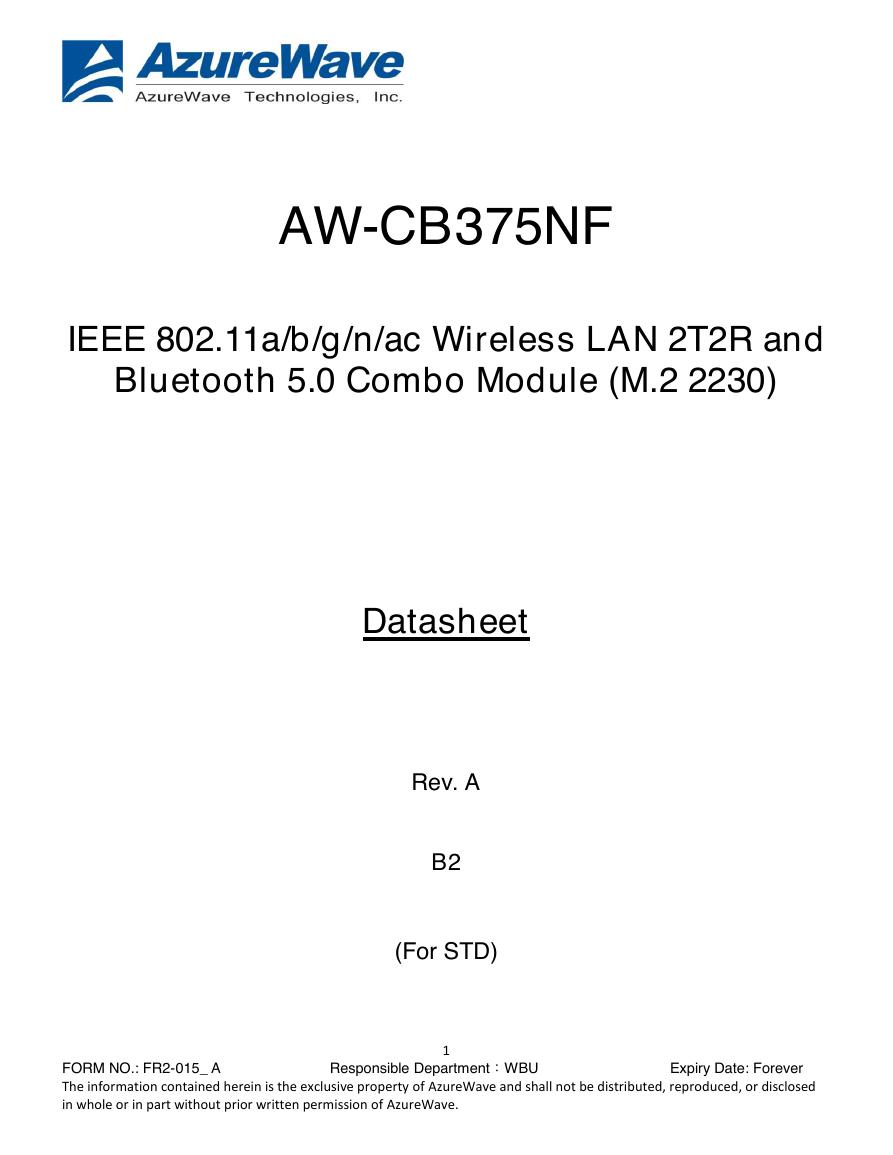
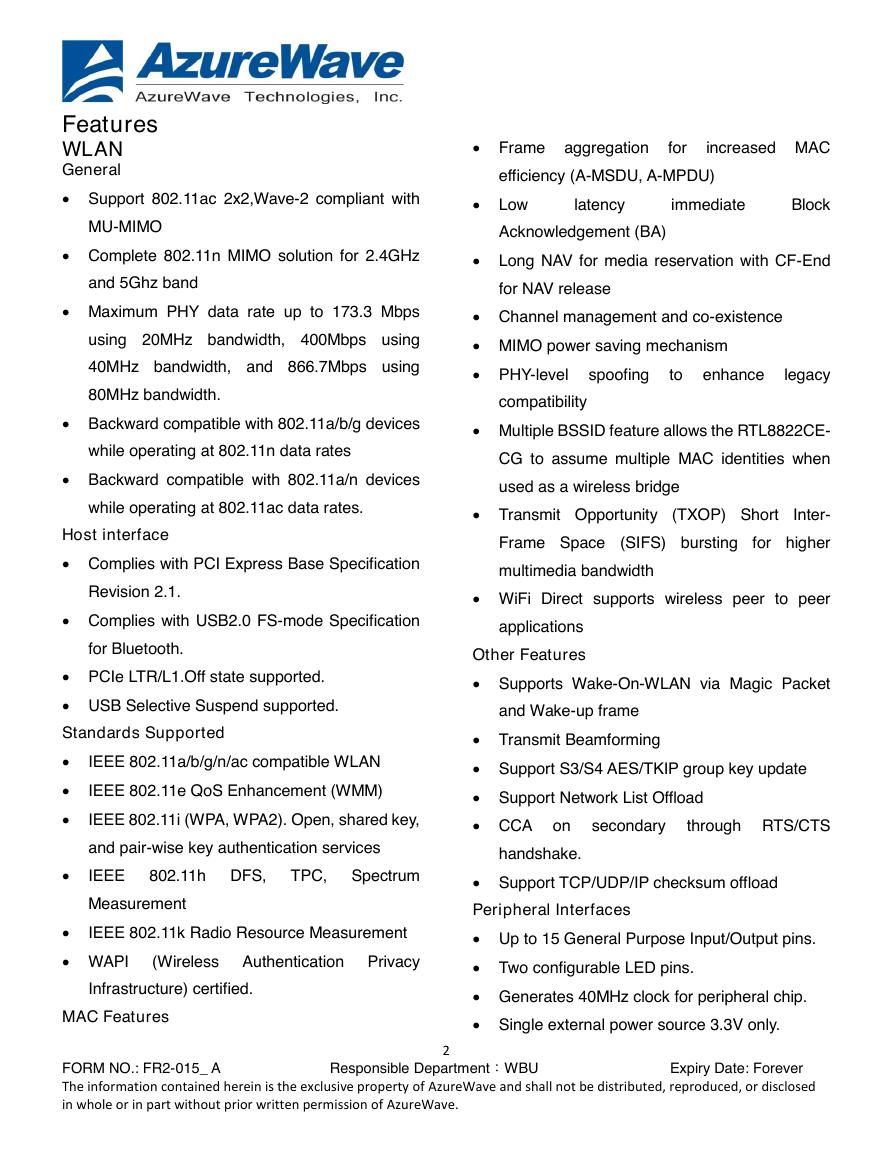
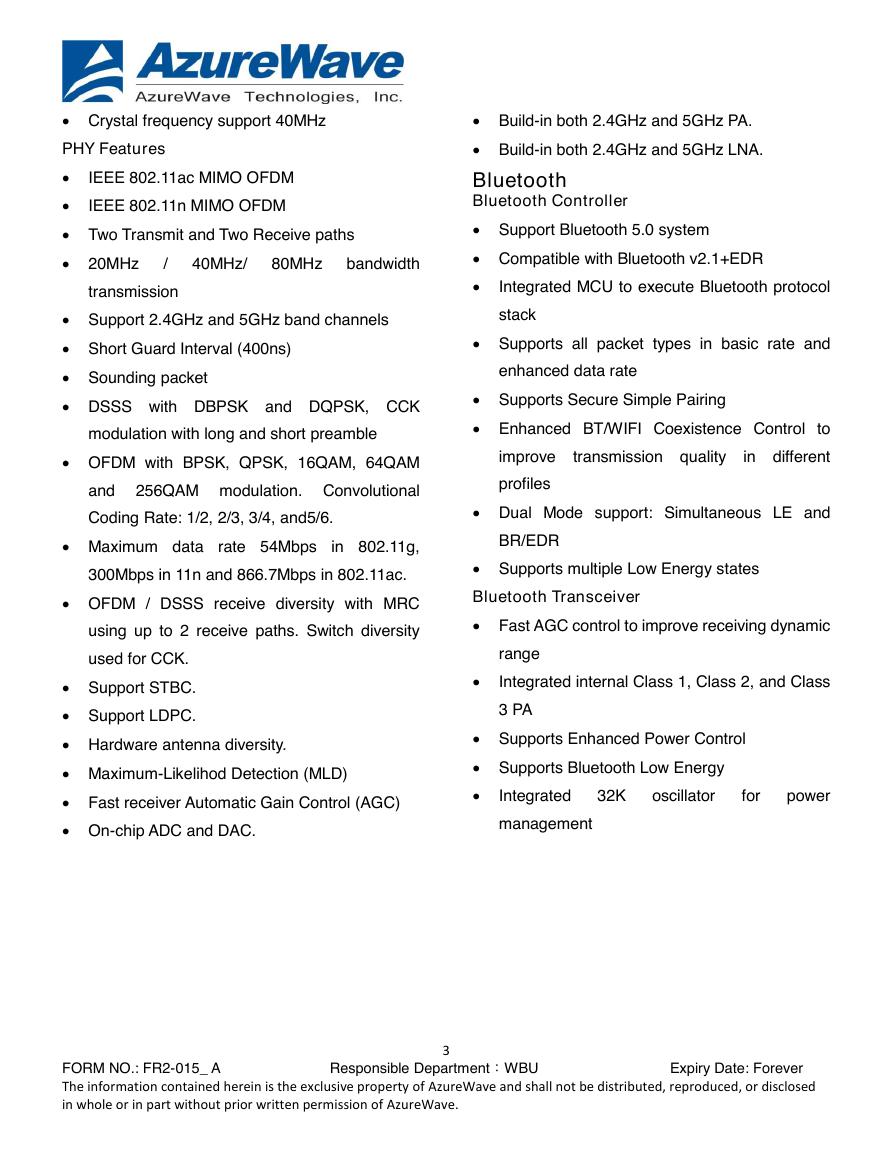
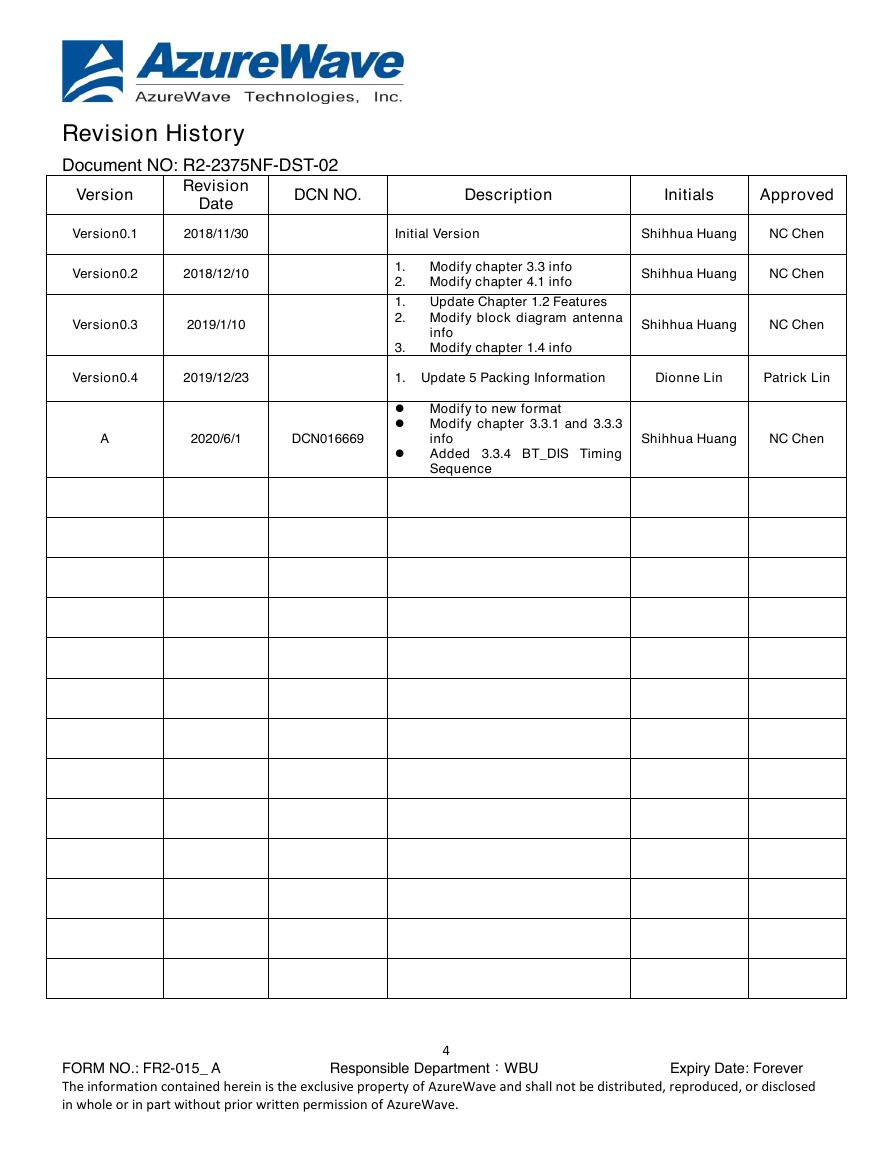
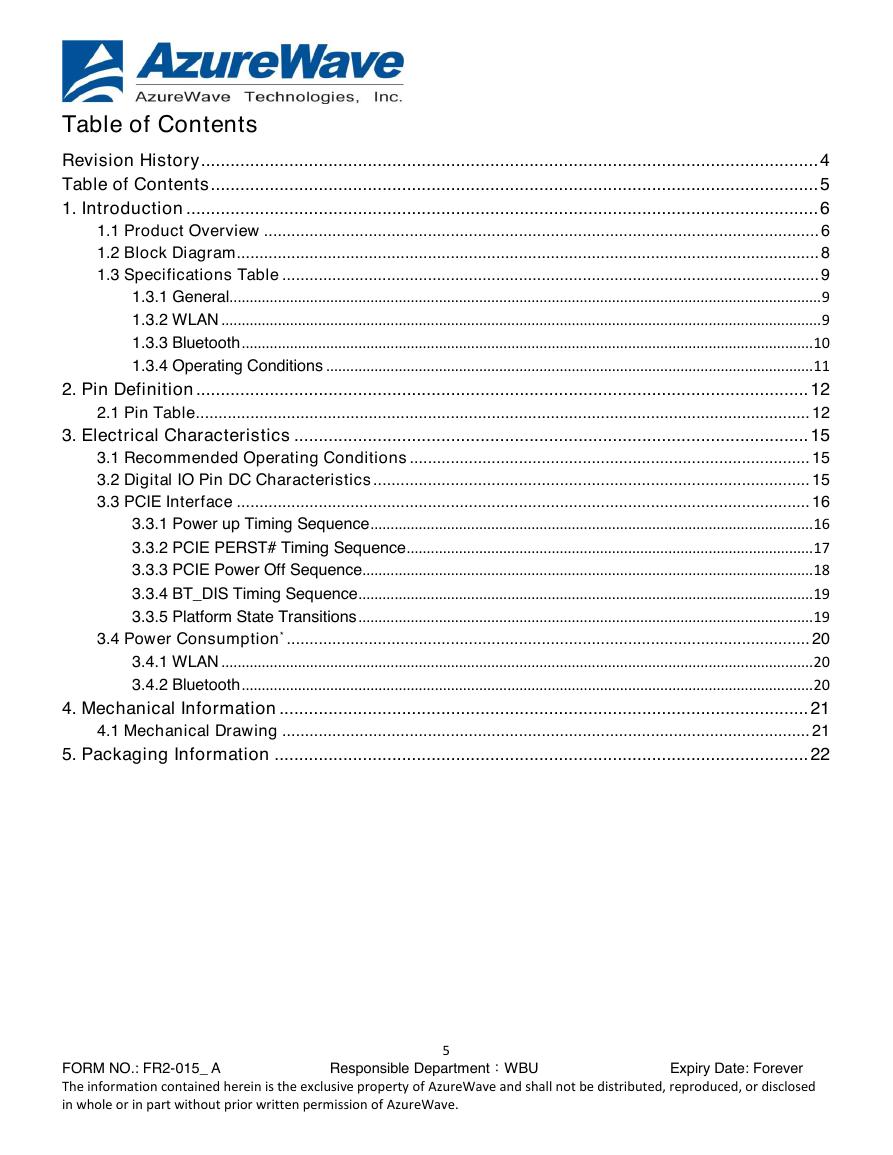
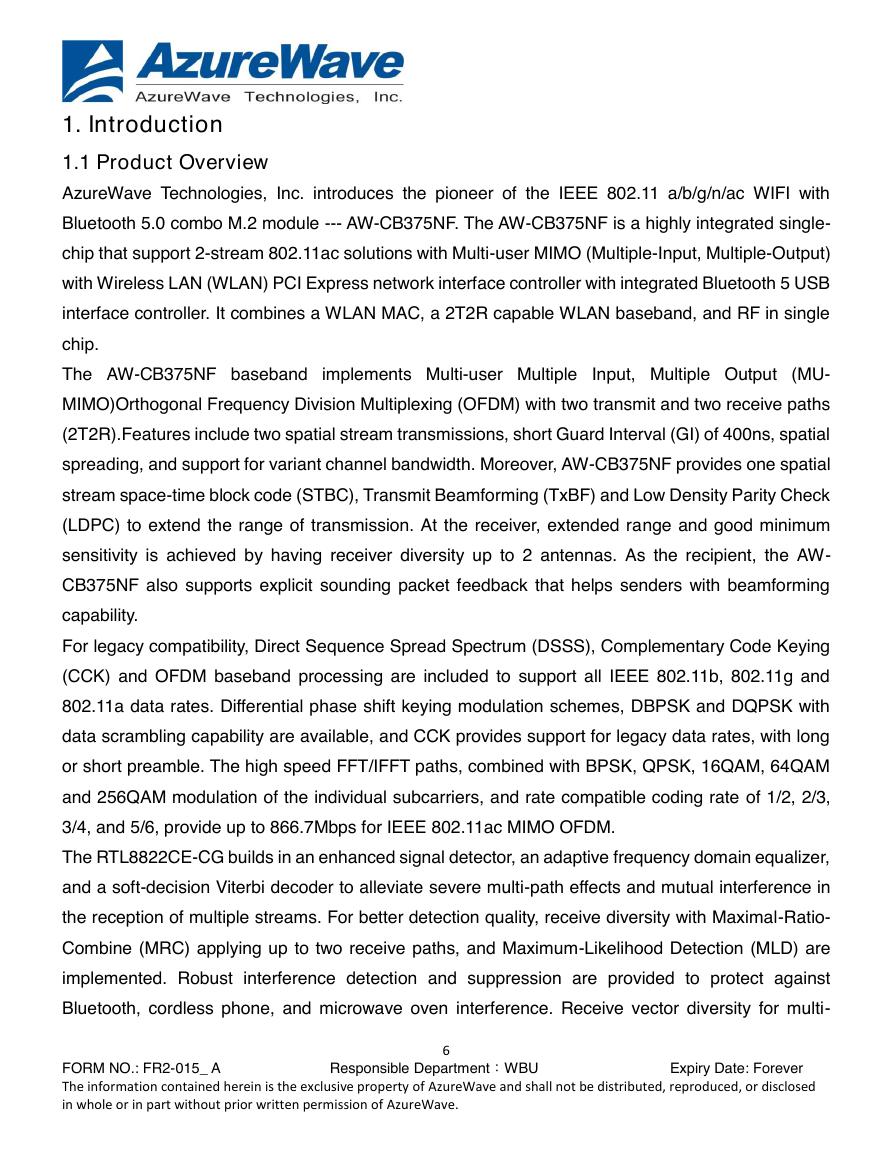
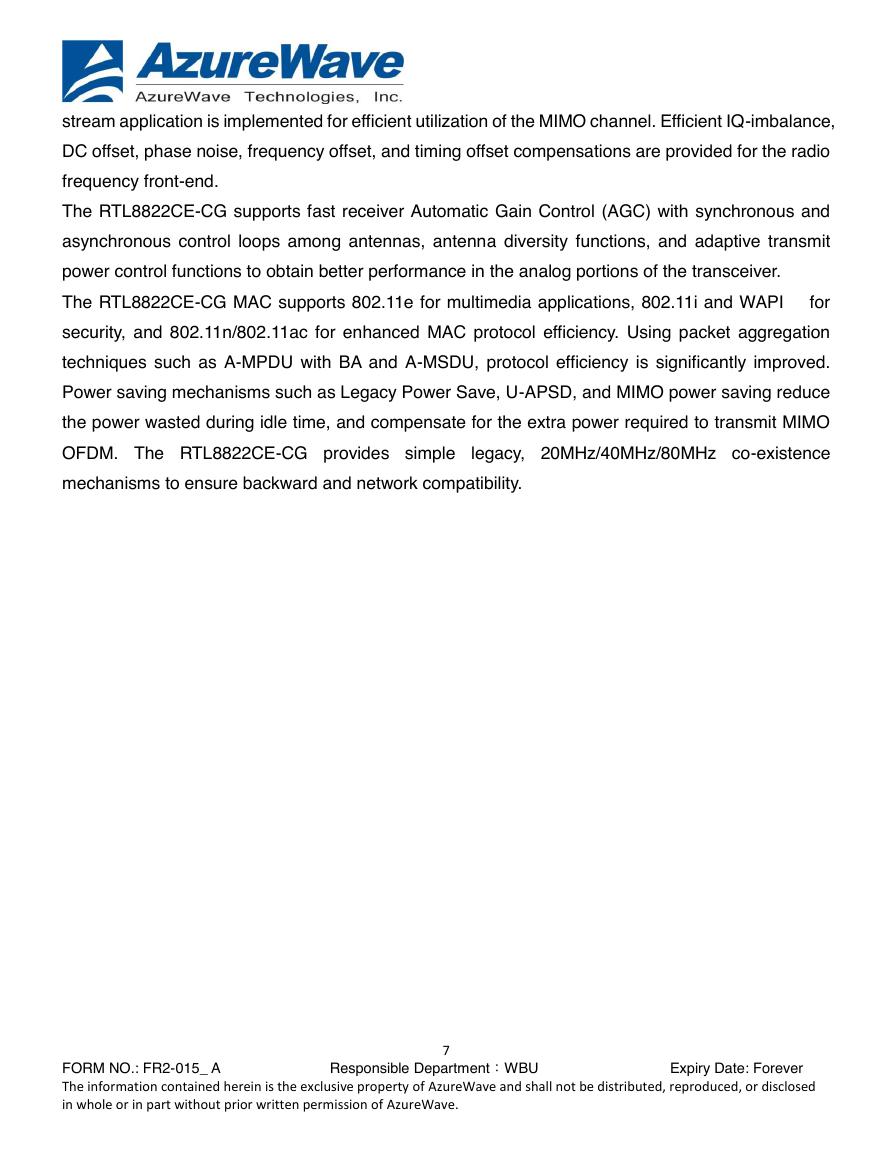
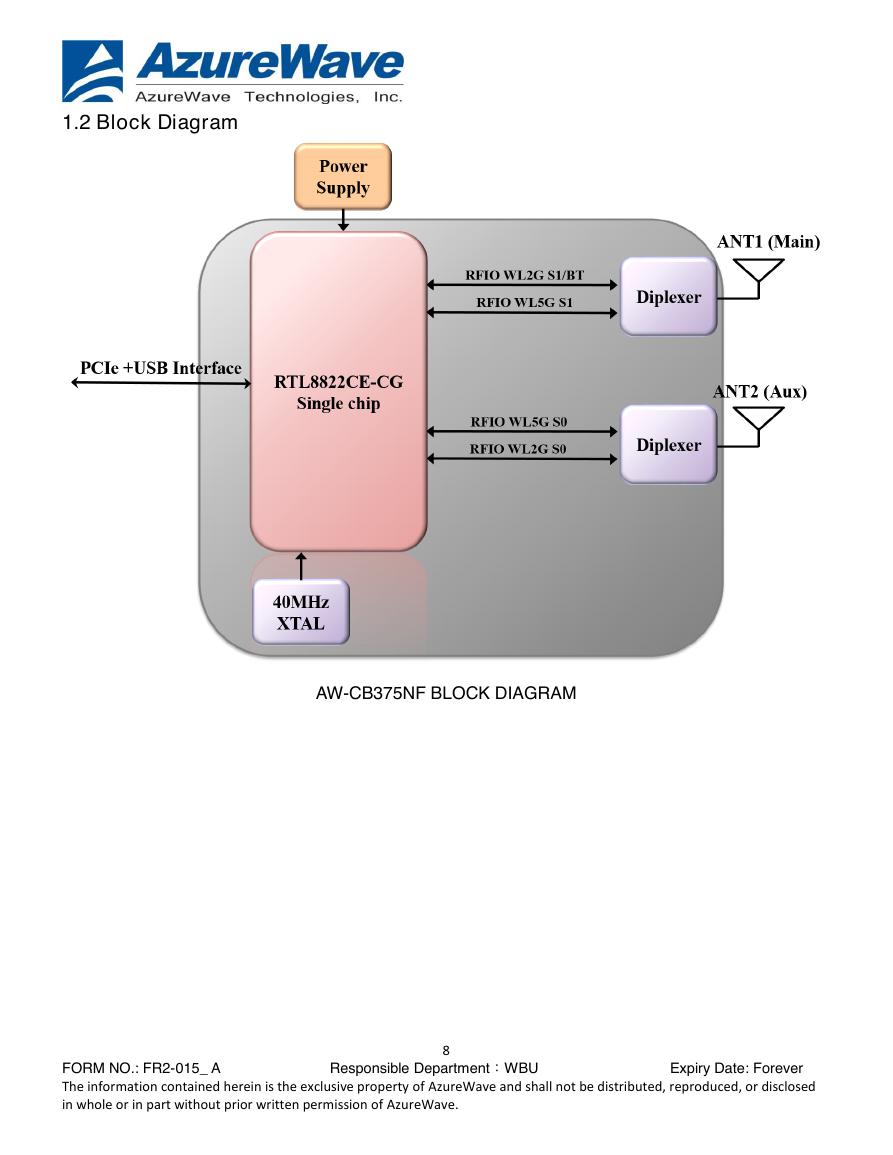








 V2版本原理图(Capacitive-Fingerprint-Reader-Schematic_V2).pdf
V2版本原理图(Capacitive-Fingerprint-Reader-Schematic_V2).pdf 摄像头工作原理.doc
摄像头工作原理.doc VL53L0X简要说明(En.FLVL53L00216).pdf
VL53L0X简要说明(En.FLVL53L00216).pdf 原理图(DVK720-Schematic).pdf
原理图(DVK720-Schematic).pdf 原理图(Pico-Clock-Green-Schdoc).pdf
原理图(Pico-Clock-Green-Schdoc).pdf 原理图(RS485-CAN-HAT-B-schematic).pdf
原理图(RS485-CAN-HAT-B-schematic).pdf File:SIM7500_SIM7600_SIM7800 Series_SSL_Application Note_V2.00.pdf
File:SIM7500_SIM7600_SIM7800 Series_SSL_Application Note_V2.00.pdf ADS1263(Ads1262).pdf
ADS1263(Ads1262).pdf 原理图(Open429Z-D-Schematic).pdf
原理图(Open429Z-D-Schematic).pdf 用户手册(Capacitive_Fingerprint_Reader_User_Manual_CN).pdf
用户手册(Capacitive_Fingerprint_Reader_User_Manual_CN).pdf CY7C68013A(英文版)(CY7C68013A).pdf
CY7C68013A(英文版)(CY7C68013A).pdf TechnicalReference_Dem.pdf
TechnicalReference_Dem.pdf